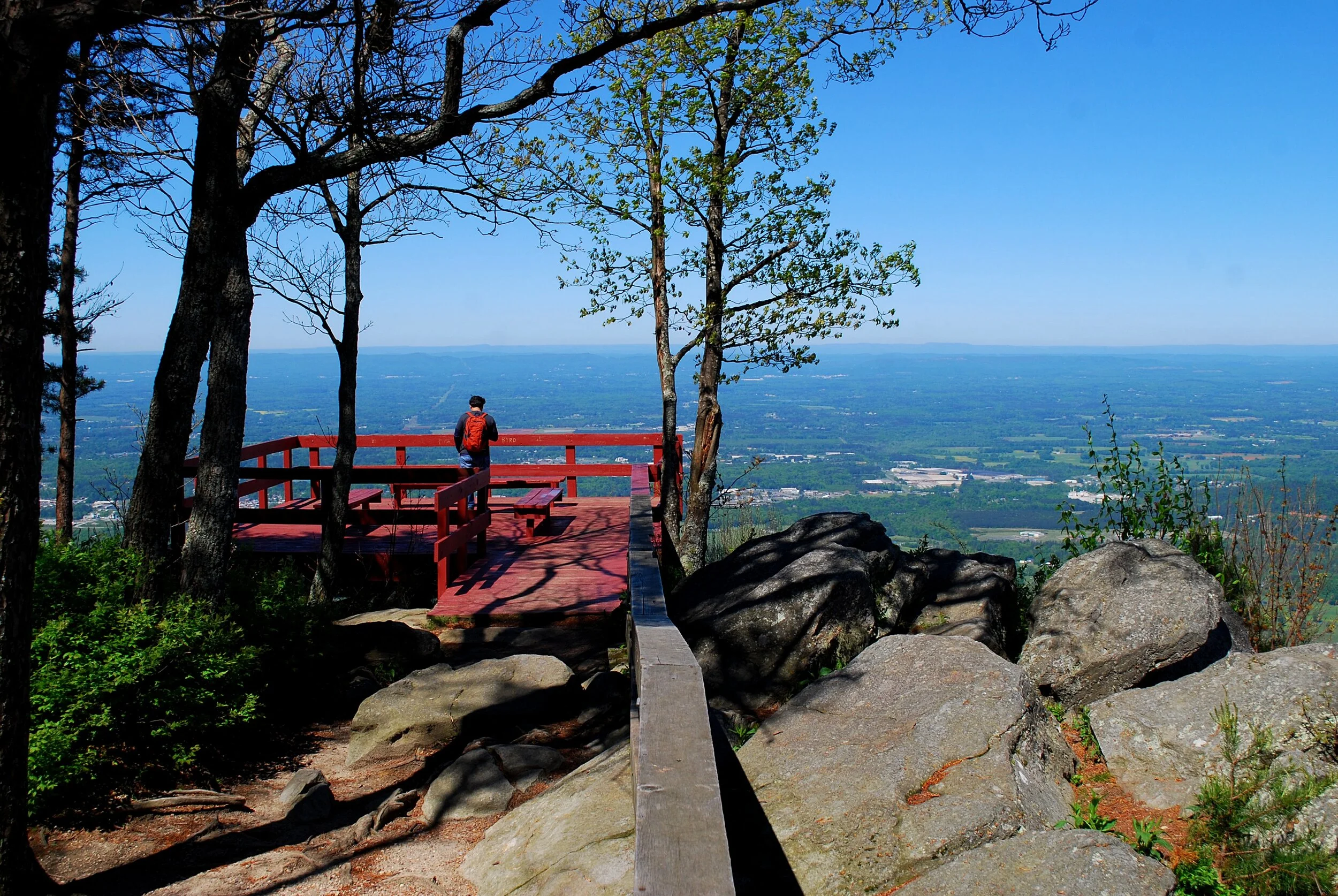Explore History and Nature in Northwest Georgia’s Fort Mountain State Park
BY BOB BUTTERS
The view from the Cools Springs Overlook. Photo © Bob Butters
A CULTURAL MYSTERY
Just east of Chatsworth, Georgia, the Cohutta Mountains form what is essentially the westernmost edge of the Blue Ridge mountain range. One of the area’s more popular outdoor destinations is Fort Mountain State Park, comprising 3,712 acres at a mountaintop elevation of about 2,000 feet above the adjacent valley floor. The park adjoins a section of the Chattahoochee National Forest.
One of the park’s best-known attractions is the mysterious wall, or “fort,”a two to six-foot high pile of stones which stretches for over 850 feet near the mountain’s summit. It is thought to have probably been higher originally. Despite many years of study, no one has yet conclusively determined just who built the wall, or why. One of the more accepted theories is that it was constructed by Native Americans around 500 A.D. for ceremonial purposes. A more intriguing theory is that it was built for defensive purposes by Welsh explorers in the 14th century after landing near present-day Mobile, Alabama. Then, there is the Cherokee legend of the “moon-eyed people,’ a race of light-skinned people who may have built the wall for defense against the natives. A lack of any artifacts at the site has contributed to the challenge of determining the wall’s origin.
In its more recent history, the land at Fort Mountain was donated to the state by former Atlanta mayor Ivan Allen, Jr., and officially became a state park in 1936. Much of the park’s early infrastructure, including the four-story-tall stone fire tower was built by the Civilian Conservation Corps.
The tower was used for spotting forest fires, as far as 40 miles away, until it was replaced by a metal tower on nearby Grassy Mountain in the 1960s. The tower’s wooded cupola burned in 1971 and was only rebuilt in 2014. Today, the tower is open on weekends from 1 - 4 p.m, weather permitting, to allow visitors to climb the wooden staircase inside up to the observation room. Though, when the surrounding trees are in leaf, you can only see a view in one direction. A much more impressive view is to be had at the nearby West Overlook.
The Civilian Conservation Corps Stone Tower. Photo © Bob Butters
WEST OVERLOOK HIKE
Beginning at the Old Fort Picnic Area parking, a relatively short hike can take in several of the park’s main attractions in a couple of hours or so. One potential option is to start by walking back down the road for a short distance to where the Gahuti Trail crosses. Turn left and follow the Gahuti Trail for a short distance to the Cool Springs Overlook, with its spectacular view of mountains to the east. Then backtrack to the connector trail on the right which links to the Stone Wall Trail. Turn right and follow it until it becomes the North Stone Tower Trail. After continuing around the northern edge of the mountain’s summit, another right turn will lead to a lengthy wooden staircase and the West Overlook. One of the most panoramic views in the Chattanooga region sweeps over 180 degrees from the neighboring mountains on each side across the valley to Lookout Mountain, about 40 miles distant on the western horizon.
After climbing back up the stairs and reaching the trail intersection again, continue straight across and you’ll shortly reach the CCC Stone Tower. Leaving the tower, take the CCC Stone Tower Trail back downhill to the parking area. About halfway back, the trail will intersect the famous stone wall. Another trail parallels the wall in each direction, allowing for further exploration.
The West Overlook. Photo © Bob Butters
MOUNTAIN BIKING, HORSEBACK RIDING, AND OTHER ACTIVITIES
In addition to its historical points of interest, Fort Mountain State Park offers an array of outdoor recreational opportunities.
Over 25 miles of hiking trails range from the 0.75 mile Big Rock Nature Trail loop to the Gahuti Trail, a challenging 8.2 mile loop. The easy 1.2 mile Lake Trail circles the park’s 17 acre lake and is open to both hikers and bikers. A variety of rental watercraft are available seasonally for use on the lake. In addition to paddling, the lake provides opportunities for fishing and swimming, and a seasonal sand beach.
27 miles of trail are available for biking. The 301 Mountain Bike Trail is also open to hiking. The 14.6 mile loop is considered by many to be one of the most beautiful and challenging mountain bike trails in the Southeast. Traversing from ridge top to valley floor and past old mines, waterfalls, and rhododendrons, the trail sees a difference of about 1,000 feet in elevation.
Horseback riders have access to over 25 miles of trail, with loops ranging from 3 to 16 miles. The horse stables and trailheads are reached from a separate entrance.
For overnight stays, the park offers 15 cottages and a wide variety of campsites, including tent, trailer, RV, walk-in, platform, pioneer, and backcountry sites, as well as a group shelter. Other amenities include picnic shelters, a playground, seasonal miniature golf, and a gift shop at the park office.
Fort Mountain State Park’s 17-acre lake. Photo © Bob Butters
GETTING THERE
If you haven’t yet explored Fort Mountain State Park, it’s definitely worth a visit, whether for an afternoon or a long weekend.
For more information about the park, including trail descriptions, a detailed trail map, hours and fees, directions, and links to nearby attractions, as well as to make reservations, visit the park’s website.





